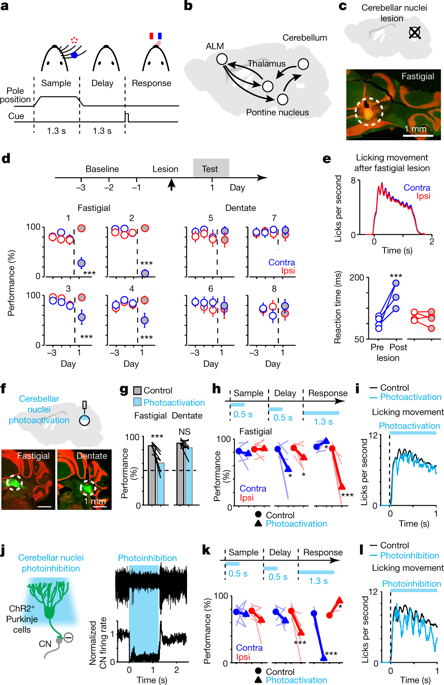Our official English website, www.x-mol.net, welcomes your
feedback! (Note: you will need to create a separate account there.)
A cortico-cerebellar loop for motor planning
Nature ( IF 50.5 ) Pub Date : 2018-10-17 , DOI: 10.1038/s41586-018-0633-x Zhenyu Gao 1 , Courtney Davis 2 , Alyse M Thomas 2 , Michael N Economo 3 , Amada M Abrego 2 , Karel Svoboda 3 , Chris I De Zeeuw 1, 4 , Nuo Li 2, 3
Nature ( IF 50.5 ) Pub Date : 2018-10-17 , DOI: 10.1038/s41586-018-0633-x Zhenyu Gao 1 , Courtney Davis 2 , Alyse M Thomas 2 , Michael N Economo 3 , Amada M Abrego 2 , Karel Svoboda 3 , Chris I De Zeeuw 1, 4 , Nuo Li 2, 3
Affiliation

|
Persistent and ramping neural activity in the frontal cortex anticipates specific movements1–6. Preparatory activity is distributed across several brain regions7,8, but it is unclear which brain areas are involved and how this activity is mediated by multi-regional interactions. The cerebellum is thought to be primarily involved in the short-timescale control of movement9–12; however, roles for this structure in cognitive processes have also been proposed13–16. In humans, cerebellar damage can cause defects in planning and working memory13. Here we show that persistent representation of information in the frontal cortex during motor planning is dependent on the cerebellum. Mice performed a sensory discrimination task in which they used short-term memory to plan a future directional movement. A transient perturbation in the medial deep cerebellar nucleus (fastigial nucleus) disrupted subsequent correct responses without hampering movement execution. Preparatory activity was observed in both the frontal cortex and the cerebellar nuclei, seconds before the onset of movement. The silencing of frontal cortex activity abolished preparatory activity in the cerebellar nuclei, and fastigial activity was necessary to maintain cortical preparatory activity. Fastigial output selectively targeted the behaviourally relevant part of the frontal cortex through the thalamus, thus closing a cortico-cerebellar loop. Our results support the view that persistent neural dynamics during motor planning is maintained by neural circuits that span multiple brain regions17, and that cerebellar computations extend beyond online motor control13–15,18.The cerebellum is critical for the coding of future movement in the frontal cortex.
中文翻译:

用于运动规划的皮质小脑环路
额叶皮层持续且逐渐增强的神经活动预示着特定的运动1-6。准备活动分布在多个大脑区域7,8,但尚不清楚涉及哪些大脑区域以及该活动如何通过多区域相互作用介导。小脑被认为主要参与运动的短时尺度控制9-12;然而,也有人提出了这种结构在认知过程中的作用13-16。对于人类来说,小脑损伤会导致计划和工作记忆缺陷13。在这里,我们表明,在运动规划过程中,额叶皮层中信息的持久表示取决于小脑。小鼠执行了一项感觉辨别任务,其中它们利用短期记忆来计划未来的定向运动。小脑内侧深部核(顶核)的短暂扰动扰乱了随后的正确反应,但不妨碍运动执行。在运动开始前几秒钟,在额叶皮层和小脑核中观察到准备活动。额叶皮层活动的沉默消除了小脑核团的准备活动,而顶叶活动对于维持皮层准备活动是必要的。小脑顶输出通过丘脑选择性地瞄准额叶皮层的行为相关部分,从而闭合皮质小脑环路。我们的结果支持这样的观点,即运动规划期间的持久神经动力学是由跨越多个大脑区域的神经回路维持的,并且小脑计算超出了在线运动控制的范围13-15,18。小脑对于额叶未来运动的编码至关重要皮质。
更新日期:2018-10-17
中文翻译:

用于运动规划的皮质小脑环路
额叶皮层持续且逐渐增强的神经活动预示着特定的运动1-6。准备活动分布在多个大脑区域7,8,但尚不清楚涉及哪些大脑区域以及该活动如何通过多区域相互作用介导。小脑被认为主要参与运动的短时尺度控制9-12;然而,也有人提出了这种结构在认知过程中的作用13-16。对于人类来说,小脑损伤会导致计划和工作记忆缺陷13。在这里,我们表明,在运动规划过程中,额叶皮层中信息的持久表示取决于小脑。小鼠执行了一项感觉辨别任务,其中它们利用短期记忆来计划未来的定向运动。小脑内侧深部核(顶核)的短暂扰动扰乱了随后的正确反应,但不妨碍运动执行。在运动开始前几秒钟,在额叶皮层和小脑核中观察到准备活动。额叶皮层活动的沉默消除了小脑核团的准备活动,而顶叶活动对于维持皮层准备活动是必要的。小脑顶输出通过丘脑选择性地瞄准额叶皮层的行为相关部分,从而闭合皮质小脑环路。我们的结果支持这样的观点,即运动规划期间的持久神经动力学是由跨越多个大脑区域的神经回路维持的,并且小脑计算超出了在线运动控制的范围13-15,18。小脑对于额叶未来运动的编码至关重要皮质。











































 京公网安备 11010802027423号
京公网安备 11010802027423号